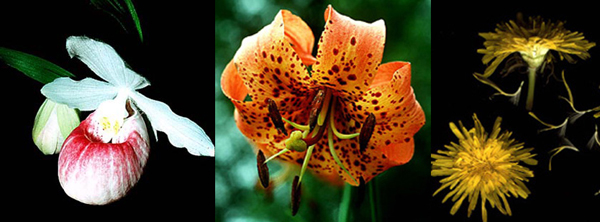Vascular
Flora of Wisconsin
- Botany 401
Spring 2020

Forest Plot Information (pdf) & Specimen Label Template (Word or fillable pdf)Choose a forest site, as pristine as possible, for your study. To avoid problems, try to locate forest site up to 20 acres for which you can get permission (friend, relative, etc.) to enter and collect a representative plant for each (non-rare) species that have adequate population sizes. Dane County or surrounding counties would be preferred (see the instructor if your site is further away). Working in groups of up to about four is helpful for both finding a site (if you are not from around this area) and car pooling. You will be required to recognize on site certain plant species that grow in your approximately 20 acre study site. This means that you should be able to provide the scientific name, the family name, and a common name for the plants. Species that you should know include all angiosperms that come into flower before the final exam, all trees and shrubs whether they flower or not, and the ferns, lycopods, and horsetails that are producing spores. You can work singly or in small groups. If small group then there should be one collection handed in, but each person will be asked to indicate how much effort they put into the collection. The deadline for picking a site (and letting your lab instructor know) is March 11 or 12 before Spring Break – preferably sooner as some trees and herbs may already be flowering. This collection of dried, pressed, identified, and fully labeled plant specimens is due at the end of the semester and is required to pass the course. Your lab instructor will grade the collection on the basis of (1) completeness of sampling for species in your site, (2) correctness of identification, (3) proper preparation of material (presence of flowers, fruits, or other reproductive parts; representative leaves, stems, and roots if possible; pressing; and drying); (4) adequate labeling; and (5) mounting of 4 specimens (check with TA on what species should be mounted; previously collected specimens but unmounted by former students may be substituted for mounting as necessary).
Do not collect in city, county, or state parks and other designated natural areas. Do not collect in the University of Wisconsin Arboretum. Collecting in these places require special permits, without which fines can be issued. Practice plant conservation in your collecting! Do not dig up entire plants, especially if you are unsure of whether the species is rare, endangered, or threatened. Become acquainted with the DNR publication (available in lab) that lists these plant species. Be careful of plants in certain communities under current stewardship or study (most prairies, including roadside remnants). Collecting the Plants 1. Plants should be collected in flower or
fruit (or other reproductive parts for non-flowering plants). Specimens
without these reproductive organs are termed "sterile", and are
not usually worth collecting. 1. The plant press is constructed out of 2
sheets of plywood (12 X 18 inches) as backing, layers of corrugated cardboard
(corrugations run cross-wise not lengthwise), and one or two layers of blotters
between cardboard. The press is kept tightly closed by two straps or ropes. Pressing Procedures 1. Plants can be collected in the field, trimmed
to the appropriate size, immediately pressed in newspaper, placed between
the two rigid ends of a plant press, and securely tightened. This "field
press" can simply consist of the end boards and precut newspaper sheet.
Later the sheets can be placed within blotters and properly dried. Alternatively,
the plants can be placed in bags and pressed later. Some plants will quickly
drop their petals or wilt so care must be taken that these plants are pressed
soon. Drying Procedures It is important that the specimens be thoroughly dried but not burned. This can be done by placing the plant press over a heat source: heater vent, fan-driven space heater, radiator, light bulbs, etc. Driers are provided in the lab. Succulent or wet specimens should have the blotters changed as needed to prevent molding. Press straps should be tightened from time to time during the drying process, to keep specimens from wrinkling.
Notes should be taken in a field notebook at the time the collection is made (not done from memory, days later at home). Each plant specimen (that is, a particular species collected at a given time and place) is given a separate number in the book. This field information is later transferred to labels that are handed in with the specimens. Labels must be produced using the available template labels on the lab computers and printed off. Locality: Designate this by county and site, accurately enough so that someone else could find the exact place later. This can be expressed by mileage along a highway, distance from a town or from some geographical feature like a hill or lake. Township, range, and section are mandatory (townships maps for Wisconsin are available in lab). Habitat: Designate this is general terms, describing the nature of the site where the plant grew. Examples are: roadside banks, open pasture, boggy meadow, shrubby thicket, shaded woods, rock slide, river bank, cliff, sand dune, etc. Important factors in plant distribution are the amount of light at the site, available moisture, nature of the soil, density of other plant growth, steepness of slope, etc. Species name: The correct name (according to UW Herbarium website) should include the genus, specific epithet, and authority. The family name should be included on the top. Thus, identification of the species can use Gleason & Cronquist, Spring Flora, Michigan Flora, Peterson Guides, etc., but final name of the species must be checked with the UW Checklist online (it will list all other names or synonyms along with the accepted name). Other necessary data: Designate the form of the plant (herb, shrub, tree, height, etc.) if this cannot be determined from the specimen. Give the original flower color. Optional information includes the names of other species growing with the this one, the soil type, the plant community, abundance of the species. The date of the collection, and your name and collection number are mandatory. Example of a typical label:
43°10'23.99"N 90° 1'17.05"W
A report must accompany your plant collection. This should include a description of the site (geographical location, vegetation type, disturbance) and a list of species (with family and common name) in the collection. Other species noted but not collected (not in flower, large trees) should be included in the description.
Each specimen is kept in its original pressing paper (or put into a clean new paper), the finished label is inserted loose along with the specimen and the collection ordered alphabetically by family. You must mount at least 3 specimens – more information will be given by your lab instructor. On the outside of the bundle, under the string, place your report. Never put tape or glue on your specimens or newspapers. Also, you must return your press.
Plant Collection Checklist ____ Collection Report: including a description
of the site (geographical location, vegetation type, disturbance), and other
species noted but not collected (not in flower, large trees).
Each and every specimen, mounted or not, MUST have a completely-filled-out label. For mounted specimens, these will be glued to the lower right-hand corner of the herbarium sheet. For unmounted specimens, the labels should be placed loose inside each folded newspaper.
Hand-lens or pocket magnifier; about 10X |

